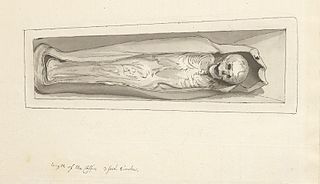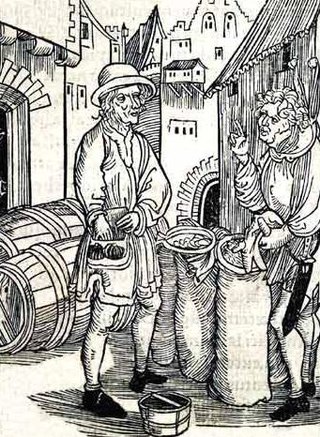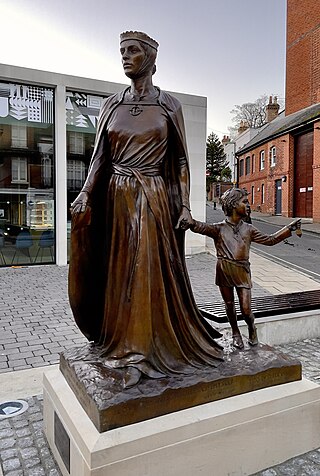Related Research Articles

Henry III, also known as Henry of Winchester, was King of England, Lord of Ireland, and Duke of Aquitaine from 1216 until his death in 1272. The son of King John and Isabella of Angoulême, Henry assumed the throne when he was only nine in the middle of the First Barons' War. Cardinal Guala Bicchieri declared the war against the rebel barons to be a religious crusade and Henry's forces, led by William Marshal, defeated the rebels at the battles of Lincoln and Sandwich in 1217. Henry promised to abide by the Great Charter of 1225, a later version of the 1215 Magna Carta, which limited royal power and protected the rights of the major barons. His early rule was dominated first by Hubert de Burgh and then Peter des Roches, who re-established royal authority after the war. In 1230, the King attempted to reconquer the provinces of France that had once belonged to his father, but the invasion was a debacle. A revolt led by William Marshal's son Richard broke out in 1232, ending in a peace settlement negotiated by the Church.

Hugh of Lincoln was an English boy whose death in Lincoln was falsely attributed to Jews. He is sometimes known as Little Saint Hugh or Little Sir Hugh to distinguish him from the adult saint, Hugh of Lincoln. The boy Hugh was not formally canonised, so "Little Saint Hugh" is a misnomer.

Usury is the practice of making unethical or immoral loans that unfairly enrich the lender. The term may be used in a moral sense—condemning taking advantage of others' misfortunes—or in a legal sense, where an interest rate is charged in excess of the maximum rate that is allowed by law. A loan may be considered usurious because of excessive or abusive interest rates or other factors defined by the laws of a state. Someone who practices usury can be called a usurer, but in modern colloquial English may be called a loan shark.

The history of the Jews in England goes back to the reign of William the Conqueror. Although it is likely that there had been some Jewish presence in the Roman period, there is no definitive evidence, and no reason to suppose that there was any community during Anglo-Saxon times. The first written record of Jewish settlement in England dates from 1070. The Jewish settlement continued until King Edward I's Edict of Expulsion in 1290.
In early modern Europe, particularly in Germany, a court Jew or court factor was a Jewish banker who handled the finances of, or lent money to, royalty and nobility. In return for their services, court Jews gained social privileges, including, in some cases, being granted noble status.
The Edict of Expulsion was a royal decree issued by Edward I of England on 18 July 1290 expelling all Jews from the Kingdom of England, the first European expulsion of Jews by a state permanently banning their presence. The date was likely chosen as it was a Jewish holy day, the ninth of Ab, which is an anniversary commemorating the destruction of Jerusalem and other disasters that the Jewish people have experienced.
It is believed that the first Jews in England arrived during the Norman Conquest of the country by William the Conqueror in 1066. The first written record of Jewish settlement in England dates from 1070. They suffered massacres in 1189–90. In 1290, all Jews were expelled from England by the Edict of Expulsion.
History of European Jews in the Middle Ages covers Jewish history in the period from the 5th to the 15th century. During the course of this period, the Jewish population gradually started shifting from the Levant to Europe, primarily Central Europe dominated by the Holy Roman Empire or Southern Europe dominated by the Iberian kingdoms. As with Christianity, the Middle Ages were the period when Judaism became mostly insignificant in the Middle East, and a front-of-mind part of Europe.

The Alhambra Decree was an edict issued on 31 March 1492, by the joint Catholic Monarchs of Spain ordering the expulsion of practicing Jews from the Crowns of Castile and Aragon and its territories and possessions by 31 July of that year. The primary purpose was to eliminate the influence of practicing Jews on Spain's large formerly-Jewish converso New Christian population, to ensure the latter and their descendants did not revert to Judaism. Over half of Spain's Jews had converted as a result of the religious persecution and pogroms which occurred in 1391. Due to continuing attacks, around 50,000 more had converted by 1415. A further number of those remaining chose to convert to avoid expulsion. As a result of the Alhambra decree and persecution in the years leading up to the expulsion of Spain's estimated 300,000 Jewish origin population, a total of over 200,000 had converted to Catholicism to remain in Spain, and between 40,000 and 100,000 remained Jewish and suffered expulsion. An unknown number of the expelled eventually succumbed to the pressures of life in exile away from formerly-Jewish relatives and networks back in Spain, and so converted to Catholicism to be allowed to return in the years following expulsion.:17
The history of the Jews in Poland before the 18th century covers the period of Jewish-Polish history from its origins, roughly until the political and socio-economic circumstances leading to the dismemberment of the Polish–Lithuanian Commonwealth in the second half of the 18th century by the neighbouring empires.
The Statute of the Jewry was a statute enacted under Edward I of England in 1275. It placed a number of restrictions on Jews of England, most notably outlawing the practice of usury.
Antisemitism in the history of the Jews in the Middle Ages became increasingly prevalent in the Late Middle Ages. Early instances of pogroms against Jews are recorded in the context of the First Crusade. Expulsions of Jews from cities and instances of blood libel became increasingly common from the 13th to the 15th century. This trend only peaked after the end of the medieval period, and it only subsided with Jewish emancipation in the late 18th and 19th centuries.
This timeline of antisemitism chronicles events in the history of antisemitism, hostile actions or discrimination against Jews as members of a religious and/or ethnic group. It includes events in Jewish history and the history of antisemitic thought, actions which were undertaken in order to counter antisemitism or alleviate its effects, and events that affected the prevalence of antisemitism in later years. The history of antisemitism can be traced from ancient times to the present day.
The Exchequer of the Jews was a division of the Court of Exchequer at Westminster which recorded and regulated the taxes and the law-cases of the Jews in England and Wales. It operated from the late 1190s until the eventual expulsion of the Jews in 1290.

The medieval English saw their economy as comprising three groups – the clergy, who prayed; the knights, who fought; and the peasants, who worked the landtowns involved in international trade. Over the five centuries of the Middle Ages, the English economy would at first grow and then suffer an acute crisis, resulting in significant political and economic change. Despite economic dislocation in urban and extraction economies, including shifts in the holders of wealth and the location of these economies, the economic output of towns and mines developed and intensified over the period. By the end of the period, England had a weak government, by later standards, overseeing an economy dominated by rented farms controlled by gentry, and a thriving community of indigenous English merchants and corporations.
The economics of English towns and trade in the Middle Ages is the economic history of English towns and trade from the Norman invasion in 1066, to the death of Henry VII in 1509. Although England's economy was fundamentally agricultural throughout the period, even before the invasion the market economy was important to producers. Norman institutions, including serfdom, were superimposed on a mature network of well-established towns involved in international trade. Over the next five centuries the English economy would at first grow and then suffer an acute crisis, resulting in significant political and economic change. Despite economic dislocation in urban areas, including shifts in the holders of wealth and the location of these economies, the economic output of towns developed and intensified over the period. By the end of the period, England would have a weak early modern government overseeing an economy involving a thriving community of indigenous English merchants and corporations.
Economic antisemitism is antisemitism that uses stereotypes and canards that are based on negative perceptions or assertions of the economic status, occupations or economic behaviour of Jews, at times leading to various governmental policies, regulations, taxes and laws that target or which disproportionately impact the economic status, occupations or behaviour of Jews.

During the Middle Ages there was a small Jewish community in Worcester, a city and county town of Worcestershire in the West Midlands of England that mainly provided money lending services to the non-Jewish citizens. Worcester also hosted a national gathering of England's leading Jews in 1241, to allow the Crown to assess their worth for taxation. The Worcester Bishopric was hostile to the Jewish community in Worcester, commissioning tracts against Jewry, and pushing for segregation of Jews and Christians. During the Second Barons' War, Jews suffered violence and many died in 1255, at the hands of Simon de Montfort's supporters.
The Expulsion of Jews from Spain was the expulsion of practicing Jews following the Alhambra Decree in 1492, which was enacted to eliminate their influence on Spain's large converso population and to ensure its members did not revert to Judaism. Over half of Spain's Jews had converted to Catholicism as a result of the Massacre of 1391. Due to continuing attacks, around 50,000 more had converted by 1415. Many of those who remained decided to convert to avoid expulsion. As a result of the Alhambra decree and the prior persecution, over 200,000 Jews converted to Catholicism, and between 40,000 and 100,000 were expelled. An unknown number returned to Spain in the following years. The expulsion led to mass migration of Jews from Spain to Italy and mostly Ottoman lands. One result of the migration was new Jewish surnames appearing in Italy and Greece. The surnames Faraggi, Farag and Farachi, for example, originated from the Spanish city of Fraga.

Licoricia of Winchester was a Jewish English moneylender. She has been described by historian Robert Stacey as "the most important Jewish woman in medieval England".
References
- 1 2 Hillaby & Hillaby 2013 , p. 104
- ↑ Stacey 2003 , pp. 51–52
- ↑ Romain, Jonathon (2013). Royal Jews: A Thousand Years of Jewish Life In and Around the Royal County of Berkshire. Grenfell. ISBN 978-0957698604.
- ↑ "The History of the Medieval Jews of England: Royal Wards". Oxford Jewish Heritage. Archived from the original on 4 October 2020. Retrieved 1 March 2018.
- ↑ Reuveni, Gideon; Wobick-segev, Sarah (2010). The Economy in Jewish History: New Perspectives on the Interrelationship Between Ethnicity and Economic Life. Berghahn Books. p. 8. ISBN 9781845459864.
- ↑ Hillaby & Hillaby 2013 , p. 106